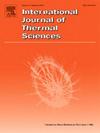微波混合连接采用SAC305-xNi@Sn焊锡膏实现卓越的性能和高效率的加热和揭示跨尺度机制
IF 4.9
2区 工程技术
Q1 ENGINEERING, MECHANICAL
International Journal of Thermal Sciences
Pub Date : 2025-05-01
DOI:10.1016/j.ijthermalsci.2025.109947
引用次数: 0
摘要
微波混合连接(MHJ)是一种创新、高效的技术,可以均匀加热材料,与传统方法相比,具有优越的性能。本研究建立了以碳化硅(SiC)为感受器的多物理体MHJ模型。SAC305-xNi@Sn发现锡膏可以复合加热,显著提高连接效率。分析了自行设计的双感受器的温度场、电场分布和最大电磁功率损耗密度分布。制备了Ni/Sn-Ag-Cu-xNi@Sn/Ni接头,并与回流焊进行了比较。分析了断裂机理和最佳Ni@Sn含量。多物理场模拟研究了MHJ的跨尺度机制。结果表明,加入3.6 g SnCl2·2H2O均匀覆盖Ni@Sn纳米颗粒,满足可焊性标准。MHJ工艺在2.45 GHz、2 kW、峰值温度400℃、曝光时间5 min时的抗剪强度为40.20 MPa,比回流焊的抗剪强度(29.63 MPa)提高35.67%。在相同工艺参数下,掺有1% Ni@Sn纳米粒子的MHJ的抗剪强度为43.11 MPa,比回流焊的抗剪强度(29.63 MPa)提高了45.49%。SAC305的厚度为3.1 mm,在9.28 GHz时的最小反射率为−53.06 dB,有效吸收带宽为2.39 GHz。Ni@Sn在4.32 GHz时的最小反射率为−2.71 dB,最佳厚度为3.04 mm。本文章由计算机程序翻译,如有差异,请以英文原文为准。
Microwave hybrid joining using SAC305-xNi@Sn solder paste to achieve superior performance and high-efficiency heating and unveiling cross-scale mechanisms
Microwave hybrid joining (MHJ) is an innovative, high-efficiency technique that uniformly heats materials, offering superior performance compared to traditional methods. This study developed a multi-physical MHJ model using silicon carbide (SiC) as the susceptor. SAC305-xNi@Sn solder paste was found to enable compound heating, significantly improving joining efficiency. The temperature field, electric field, and maximum electromagnetic power loss density distributions of the self-designed dual susceptors were analyzed. Ni/Sn-Ag-Cu-xNi@Sn/Ni joints were fabricated and compared with reflow soldering. The fracture mechanism and the optimal Ni@Sn content were analyzed. The multi-physics simulation examined the cross-scale mechanisms of MHJ. The results indicate that incorporating 3.6 g of SnCl2·2H2O uniformly covers Ni@Sn nanoparticles, meeting weldability standards. MHJ technology achieves a shear strength of 40.20 MPa at 2.45 GHz, 2 kW, a peak temperature of 400 °C, and a 5-min exposure time, which is 35.67 % higher than that of reflow soldering (29.63 MPa). Under identical process parameters, MHJ infused with 1 % Ni@Sn nanoparticles achieves a shear strength of 43.11 MPa, representing a 45.49 % increase over the shear strength of reflow soldering (29.63 MPa). SAC305 has a thickness of 3.1 mm, a minimum reflectance of −53.06 dB at 9.28 GHz, and an effective absorption bandwidth of 2.39 GHz. Ni@Sn exhibits a minimum reflectance of −2.71 dB and an optimal thickness of 3.04 mm at 4.32 GHz.
求助全文
通过发布文献求助,成功后即可免费获取论文全文。
去求助
来源期刊

International Journal of Thermal Sciences
工程技术-工程:机械
CiteScore
8.10
自引率
11.10%
发文量
531
审稿时长
55 days
期刊介绍:
The International Journal of Thermal Sciences is a journal devoted to the publication of fundamental studies on the physics of transfer processes in general, with an emphasis on thermal aspects and also applied research on various processes, energy systems and the environment. Articles are published in English and French, and are subject to peer review.
The fundamental subjects considered within the scope of the journal are:
* Heat and relevant mass transfer at all scales (nano, micro and macro) and in all types of material (heterogeneous, composites, biological,...) and fluid flow
* Forced, natural or mixed convection in reactive or non-reactive media
* Single or multi–phase fluid flow with or without phase change
* Near–and far–field radiative heat transfer
* Combined modes of heat transfer in complex systems (for example, plasmas, biological, geological,...)
* Multiscale modelling
The applied research topics include:
* Heat exchangers, heat pipes, cooling processes
* Transport phenomena taking place in industrial processes (chemical, food and agricultural, metallurgical, space and aeronautical, automobile industries)
* Nano–and micro–technology for energy, space, biosystems and devices
* Heat transport analysis in advanced systems
* Impact of energy–related processes on environment, and emerging energy systems
The study of thermophysical properties of materials and fluids, thermal measurement techniques, inverse methods, and the developments of experimental methods are within the scope of the International Journal of Thermal Sciences which also covers the modelling, and numerical methods applied to thermal transfer.
 求助内容:
求助内容: 应助结果提醒方式:
应助结果提醒方式:


